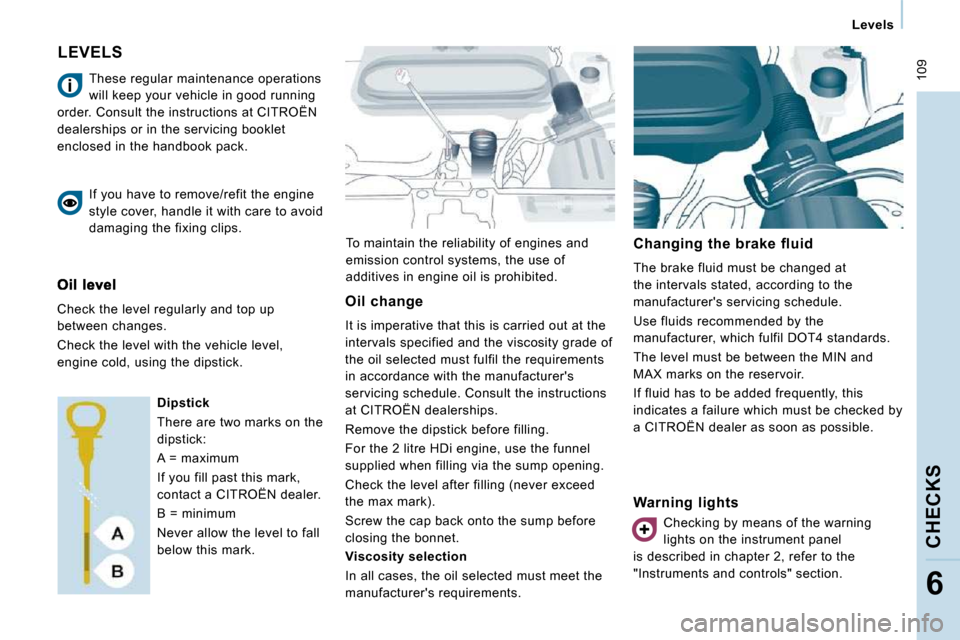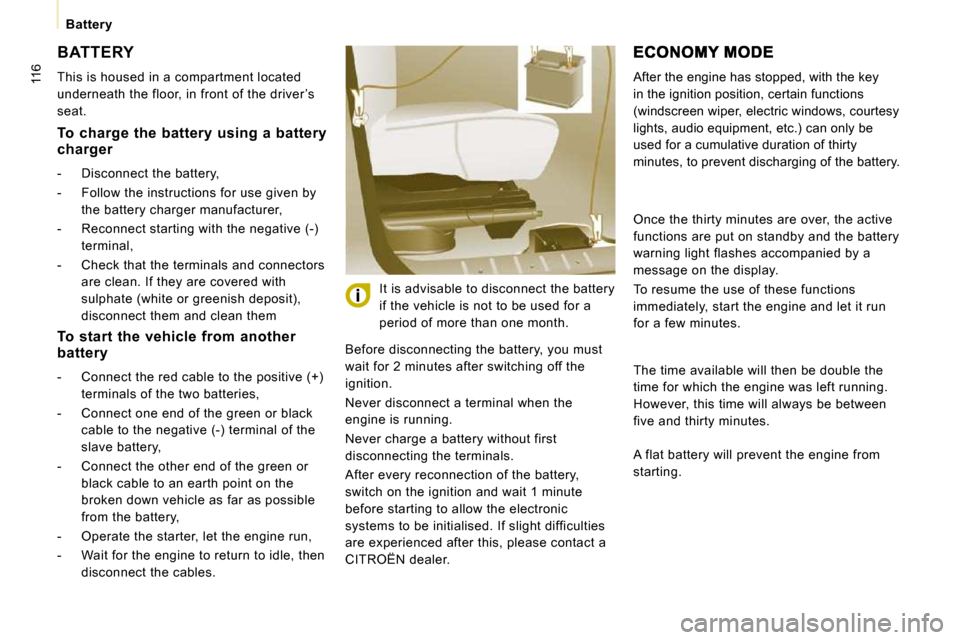warning lights Citroen JUMPY MULTISPACE 2009.5 2.G User Guide
[x] Cancel search | Manufacturer: CITROEN, Model Year: 2009.5, Model line: JUMPY MULTISPACE, Model: Citroen JUMPY MULTISPACE 2009.5 2.GPages: 231, PDF Size: 11.45 MB
Page 104 of 231

109
Levels
CHECKS
6
LEVELS
To maintain the reliability of engines and
emission control systems, the use of
additives in engine oil is prohibited. Changing the brake fluid
The brake fluid must be changed at
the intervals stated, according to the
manufacturer's servicing schedule.
Use fluids recommended by the
manufacturer, which fulfil DOT4 standards.
The level must be between the MIN and
MAX marks on the reservoir.
If fluid has to be added frequently, this
indicates a failure which must be checked by
a CITROËN dealer as soon as possible.
These regular maintenance operations
will keep your vehicle in good running
order. Consult the instructions at CITROËN
dealerships or in the servicing booklet
enclosed in the handbook pack.
If you have to remove/refit the engine
style cover, handle it with care to avoid
damaging the fixing clips.
Check the level regularly and top up
between changes.
Check the level with the vehicle level,
engine cold, using the dipstick. Dipstick
There are two marks on the
dipstick:
A = maximum
If you fill past this mark,
contact a CITROËN dealer.
B = minimum
Never allow the level to fall
below this mark. Oil change
It is imperative that this is carried out at the
intervals specified and the viscosity grade of
the oil selected must fulfil the requirements
in accordance with the manufacturer's
servicing schedule. Consult the instructions
at CITROËN dealerships.
Remove the dipstick before filling.
For the 2 litre HDi engine, use the funnel
supplied when filling via the sump opening.
Check the level after filling (never exceed
the max mark).
Screw the cap back onto the sump before
closing the bonnet.
Viscosity selection
In all cases, the oil selected must meet the
manufacturer's requirements.
Warning lights
Checking by means of the warning
lights on the instrument panel
is described in chapter 2, refer to the
"Instruments and controls" section.
Page 111 of 231

116
Battery
BATTERY
This is housed in a compartment located
underneath the floor, in front of the driver ’s
seat. Before disconnecting the battery, you must
wait for 2 minutes after switching off the
ignition.
Never disconnect a terminal when the
engine is running.
Never charge a battery without first
disconnecting the terminals.
After every reconnection of the battery,
switch on the ignition and wait 1 minute
before starting to allow the electronic
systems to be initialised. If slight difficulties
are experienced after this, please contact a
CITROËN dealer. It is advisable to disconnect the battery
if the vehicle is not to be used for a
period of more than one month. After the engine has stopped, with the key
in the ignition position, certain functions
(windscreen wiper, electric windows, courtesy
lights, audio equipment, etc.) can only be
used for a cumulative duration of thirty
minutes, to prevent discharging of the battery.
To charge the battery using a battery charger
- Disconnect the battery,
- Follow the instructions for use given by
the battery charger manufacturer,
- Reconnect starting with the negative (-) terminal,
- Check that the terminals and connectors are clean. If they are covered with
sulphate (white or greenish deposit),
disconnect them and clean them
To start the vehicle from another battery
- Connect the red cable to the positive (+) terminals of the two batteries,
- Connect one end of the green or black cable to the negative (-) terminal of the
slave battery,
- Connect the other end of the green or black cable to an earth point on the
broken down vehicle as far as possible
from the battery,
- Operate the starter, let the engine run,
- Wait for the engine to return to idle, then disconnect the cables. Once the thirty minutes are over, the active
functions are put on standby and the battery
warning light flashes accompanied by a
message on the display.
To resume the use of these functions
immediately, start the engine and let it run
for a few minutes.
The time available will then be double the
time for which the engine was left running.
However, this time will always be between
five and thirty minutes.
A flat battery will prevent the engine from
starting.
Page 223 of 231

9.80
�0�8
1
2
2
2
2
2
2
1
2
2
1
2
2
2
2
2
1
2
2
1
2
3
3
2
2
1
1
1
GENERAL MENU A
> GENERAL MENU > GENERAL MENU A
This displays the following information, via the audio equipment control pad: - the time, - the date, � � �-� � �t�h�e� �e�x�t�e�r�i�o�r� �t�e�m�p�e�r�a�t�u�r�e� �(�t�h�i�s� �fl� �a�s�h�e�s� �i�f� �t�h�e�r�e� �i�s� �a� �r�i�s�k� �o�f� �i�c�e�)�,� - the audio source displays (radio, CD, ...), - the warning messages or information messages d isplayed temporarily, can be cleared by pressing the "ESC" button, - the trip computer (see 9.76).
DISPLAY ADJUST UNITS
RADIO-CD
REG MODE
RDS SEARCH
INTROSCAN
CD REPEAT
RANDOM PLAY
� � �W�I�P�I�N�G� �I�N� �R�E�V�E�R�S�E� �G�E�A�R� �
PARKING ASSISTANCE
OPTIONS
AUTO LIGHTS
FOLLOW-ME-HOME LIGHTING
� � �V�E�H�I�C� �C�O�N�F�I�G�
ABANDON/CONSULT LIST OF FAULTS
� � �f�u�n�c�t�i�o�n�s� �a�c�t�i�v�a�t�e�d� �(�o�r� �n�o�t�)� �
� � �w�a�r�n�i�n�g� �m�e�s�s�a�g�e�s� � � �
DISPLAY ADJUST
LANGUAGES
UNITS
YEAR
MONTH
DAY
HOUR
MINUTES
� � �1�2� �H�R�/�2�4� �H�R� �M�O�D�E� � �
� � �T�E�M�P�E�R�A�T�U�R�E�:� �°�C�E�L�S�I�U�S�/�°�F�A�H�R�E�N�H�E�I�T� �
� � �F�U�E�L� �C�O�N�S�U�M�P�T�I�O�N�:� �K�M�/�L� �-� �L�/�1�0�0� �-� �M�P�G� � � �